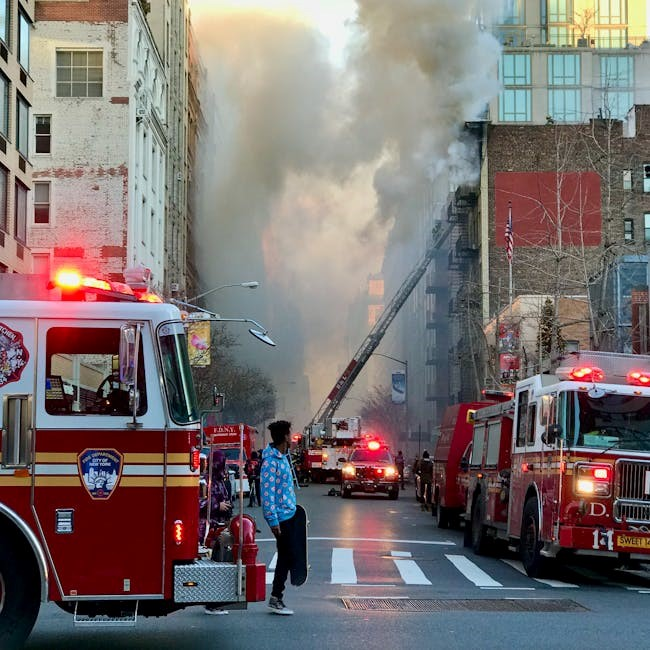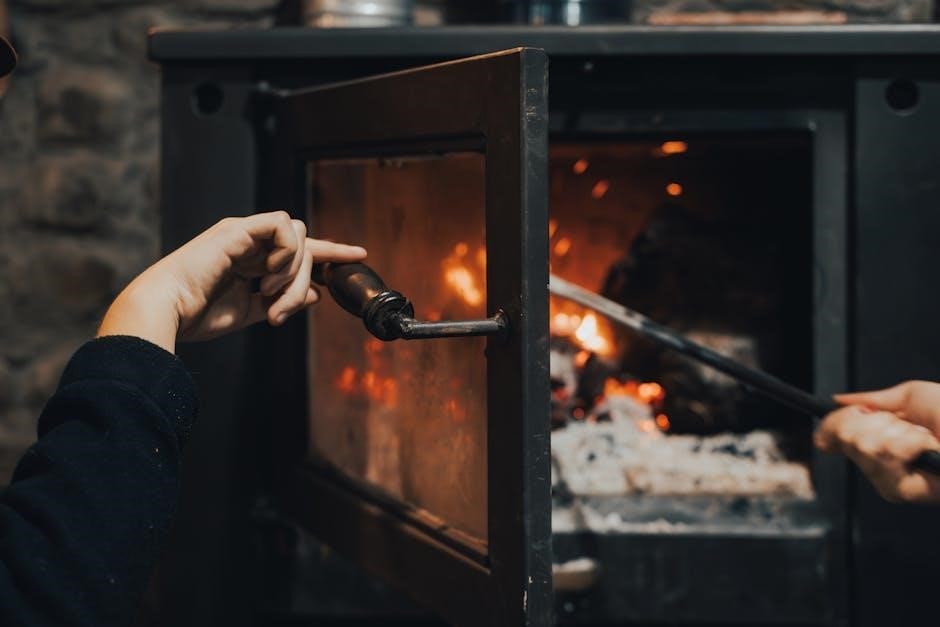Welcome to the Firex Fire Alarm Manual, your guide to understanding and utilizing your smoke alarm effectively․ This manual provides essential information for installation, operation, and maintenance․ Designed to enhance home safety, Firex smoke alarms feature advanced detection technologies like ionization and SMART HUSHTM control․ By following this manual, you ensure compliance with safety standards and optimal performance of your Firex smoke alarm․
Overview of the Firex Fire Alarm Manual
The Firex Fire Alarm Manual is a comprehensive guide designed to help users understand and properly utilize their smoke alarm systems․ It covers essential details about models such as FADC, AD, and ADC, highlighting their unique features like interconnectivity and False Alarm Control․ The manual provides step-by-step installation instructions, operation tips, and troubleshooting solutions․ It also emphasizes compliance with safety standards and offers maintenance advice to ensure optimal performance․ By following this manual, users can maximize their fire safety measures and enjoy peace of mind knowing their system is functioning correctly․ It is a vital resource for both installers and homeowners․
Importance of Reading the Manual
Reading the Firex Fire Alarm Manual is crucial for ensuring your smoke alarm functions correctly and provides optimal protection․ It helps you understand proper installation, operation, and maintenance, preventing potential hazards․ The manual details essential features like SMART HUSHTM control and False Alarm Control, enabling you to utilize the device effectively․ It also guides troubleshooting and compliance with safety standards, ensuring your system meets regulatory requirements․ By following the manual, you can avoid common mistakes, prolong the alarm’s lifespan, and maintain a safe living environment․ Taking the time to read and understand the manual is a vital step in safeguarding your home and family․

Key Features of Firex Smoke Alarms
Firex smoke alarms boast advanced features designed for reliability and effectiveness․ They utilize ionization and photoelectric detection technologies to accurately identify smoke particles․ The SMART HUSHTM control minimizes nuisance alarms by temporarily silencing false triggers․ Some models include a test/hush button for easy functionality checks and a 9V battery backup for continuous operation during power outages․ Select models offer False Alarm Control, which quiets unwanted alerts for up to 15 minutes․ These alarms are also compatible with interconnected systems, allowing multiple units to communicate and enhance overall home safety․ With features tailored to reduce false alarms and improve detection accuracy, Firex smoke alarms provide a robust defense against fire hazards․

Installation Guidelines
Locate the arrow on the alarm’s front face and insert a flat-bladed screwdriver horizontally above it․ Install the battery and mount the alarm securely following manual instructions;
Step-by-Step Installation Process
To install your Firex smoke alarm, begin by locating the arrow on the front face․ Insert a flat-bladed screwdriver horizontally above the arrow and gently pry open the mounting plate․ Ensure the surface is clean and dry before securing the base plate․ Mount the alarm firmly, making sure it is level․ Insert the battery, ensuring proper orientation, and replace the cover․ Test the alarm by pressing the test/hush button to confirm it is functioning correctly․ Refer to the manual for specific model instructions and safety precautions to ensure proper installation and functionality․
Interconnectivity with Other Firex Models
Firex smoke alarms can be interconnected with up to 11 other compatible models, including FADC, AD, ADC, and TPCI․ This feature ensures all alarms sound simultaneously in case of a fire․ Models like FADCQ and COQ8 are fully compatible with existing FireX systems, allowing seamless integration․ The interconnect wire can be shared with smoke and heat alarms, enhancing system functionality․ Always refer to the manual to confirm compatibility and follow specific instructions for wiring and setup․ Proper interconnectivity ensures comprehensive home safety and meets residential smoke alarm standards․ This feature is a key advantage of Firex systems, providing enhanced protection․
Choosing the Right Location for Installation
Proper placement of your Firex smoke alarm is crucial for effective fire detection․ Install alarms on every level of your home and inside each sleeping area for comprehensive coverage․ Position them at least 10 feet away from cooking appliances to reduce nuisance alarms․ Avoid installing in attics, garages, or areas with high humidity or extreme temperatures․ Choose locations that provide optimal air circulation to ensure accurate detection․ For models like FADC and ADC, follow the manufacturer’s guidelines to ensure compliance with safety standards․ Correct installation height and spacing are essential for reliable performance and to meet local fire safety regulations․ Ensure your family’s safety by selecting the right location․
MOUNTING THE ALARM
To mount the Firex smoke alarm, locate the arrow on the front face and insert a flat-bladed screwdriver horizontally into the slot above it․ This ensures proper alignment and secure installation․ For models like FADC and ADC, the alarm must be mounted on a wall or ceiling, typically 4-12 inches from the ceiling․ Ensure the mounting bracket is firmly secured to the wall or ceiling surface․ Some models, such as KF10 and KF20, require the battery to be installed before mounting․ Once the bracket is in place, turn the alarm clockwise to lock it securely․ Proper mounting is essential for reliable performance and safety compliance․

Models and Specifications
Firex offers a range of smoke alarm models, including FADC, AD, and ADC, each featuring ionization or photoelectric detection and advanced technologies like SMART HUSHTM control for reduced false alarms․
Different Firex Smoke Alarm Models (e․g․, FADC, AD, ADC)
Firex offers a variety of smoke alarm models to meet different safety needs․ The FADC model features ionization detection, False Alarm Control, and a battery backup, ensuring reliable performance․ The AD model is a basic ionization smoke alarm designed for straightforward installation and operation․ The ADC model is similar to the AD but includes additional features like a test/hush button for easy maintenance․ Other models, such as the i4618, incorporate advanced technologies like SMART HUSHTM control to minimize false alarms․ Each model is designed to provide consistent and accurate fire detection, ensuring a safe and secure environment for homeowners․
Technical Specifications of Each Model
Firex smoke alarm models vary in features and capabilities․ The FADC model operates on 120V AC with a 9V battery backup, incorporating ionization detection and SMART HUSHTM control․ The AD model is a basic ionization smoke alarm with a 9V battery, suitable for simple installations․ The ADC model includes a test/hush button for easy maintenance and false alarm control․ Other models, like the i4618, feature advanced ionization detection with a front-loading battery design․ All models meet residential smoke alarm standards, ensuring reliability and safety․ Technical specifications ensure compatibility with other Firex products, allowing for interconnected systems to enhance home safety․
Model Numbers and Their Unique Features
Firex smoke alarm models are distinguished by their unique features and functionalities․ The FADC model includes ionization detection, a 9V battery backup, and SMART HUSHTM control for reducing nuisance alarms․ The AD model is a basic ionization smoke alarm with a 9V battery, ideal for straightforward installations․ The ADC model adds a test/hush button for easy maintenance and false alarm control․ Other models, such as the i4618, feature advanced ionization detection with a front-loading battery design․ Each model is designed to meet specific safety needs, ensuring compatibility with other Firex products for interconnected systems․ These unique features enhance home safety and user convenience․

Compatibility with Other Firex Products
Firex smoke alarms are designed to seamlessly integrate with other Firex models, ensuring enhanced safety and reliability․ Models such as FADC, AD, ADC, and i4618 can interconnect with up to 11 other Firex units, including smoke, heat, and carbon monoxide alarms․ This interconnectivity allows for a unified safety system, where one alarm triggering alerts all connected devices․ Additionally, models like the 21033081 are compatible with Firex’s SMART HUSHTM technology, reducing nuisance alarms․ Compatibility extends to Firex heat alarms (e․g․, ADH) and CO alarms (e․g․, COQ8), ensuring comprehensive protection․ This versatility makes Firex products ideal for creating a cohesive home safety network․

Operation and Functionality
Firex smoke alarms feature advanced detection technologies, including ionization and photoelectric sensors, ensuring reliable fire detection․ Equipped with SMART HUSHTM control, they minimize false alarms while maintaining safety․ The test/hush button allows for quick functionality checks and temporary silencing of nuisance alarms, enhancing user convenience without compromising protection․ These alarms are designed to operate seamlessly, providing clear alerts and peace of mind for homeowners․
Understanding Ionization vs․ Photoelectric Detection
Firex smoke alarms utilize two primary detection technologies: ionization and photoelectric․ Ionization alarms detect smoke by monitoring ionization levels in the air, ideal for fast-flaming fires․ Photoelectric alarms use light scattering to identify larger smoke particles, better suited for smoldering fires․ Firex models like the FADC and ADC use ionization, while others, such as the GC240 and I240C, incorporate photoelectric technology․ Both types ensure reliable detection, but their differences in sensing capabilities make them suitable for various fire scenarios․ Firex alarms may combine these technologies for comprehensive protection, offering advanced features like false alarm control and SMART HUSHTM for enhanced functionality and safety․
False Alarm Control Feature
The Firex smoke alarms feature a False Alarm Control system, designed to minimize unwanted activations․ This advanced technology temporarily quiets the alarm for up to 15 minutes, reducing disruptions caused by cooking or steam․ Models like the FADC and ADC include this feature, ensuring a balance between safety and convenience․ When activated, the system distinguishes between nuisance triggers and actual threats, providing reliable detection without unnecessary alerts․ This feature enhances user experience while maintaining the alarm’s critical safety functions, making it ideal for homes where false alarms are a common issue․ Proper use of this feature ensures optimal performance and peace of mind for users․
SMART HUSHTM Control Explained
SMART HUSHTM Control is an innovative feature designed to reduce nuisance alarms while maintaining reliable fire detection․ This technology allows users to temporarily silence false alarms caused by cooking smoke or steam; By pressing the test/hush button, the alarm is muted for a short period, providing convenience without compromising safety․ The system automatically resumes monitoring after the silence period, ensuring continuous protection․ This feature is particularly useful in kitchens or areas prone to false triggers․ SMART HUSHTM Control enhances user experience by minimizing interruptions while maintaining the alarm’s critical function of detecting real threats․ It is a key advantage of Firex smoke alarms, offering practicality and efficiency․
Test/Hush Button Functionality
The test/hush button on Firex smoke alarms serves dual purposes: testing the alarm’s functionality and silencing nuisance alarms․ Pressing the button checks the unit’s operability, ensuring it sounds correctly․ During a false alarm, such as from cooking, the same button mutes the alert temporarily․ Models like FADC, AD, and ADC support this feature․ To test, press and hold the button until the alarm sounds, confirming it works․ For hushing, a short press will silence the unit․ This feature enhances user convenience without compromising safety․ Always ensure the alarm resumes monitoring after the hush period to maintain protection․ Regular testing is recommended to ensure reliability․ This button is a key tool for managing your Firex smoke alarm effectively․ Use it wisely to avoid unnecessary disruptions while keeping your home safe․

Troubleshooting
Identify common issues like false alarms or connectivity problems․ Use the hush button to silence nuisance alerts․ Check interconnections and battery installation for proper functionality․ Ensure alarms are clean and free from obstructions for accurate detection․ Refer to the manual for detailed solutions and resetting procedures to restore optimal performance․ Regular maintenance can prevent many issues, ensuring your Firex smoke alarm operates reliably․ Always address problems promptly to maintain home safety and security․ Troubleshooting helps extend the lifespan and effectiveness of your smoke alarm system․ Stay proactive with checks and repairs․
Common Issues and Solutions
Common issues with Firex smoke alarms include false alarms, often caused by cooking or steam․ Use the hush button to temporarily silence the alarm․ If the alarm fails to activate, check for proper installation and battery connection․ Dust or debris in the sensor can cause malfunctions; clean the alarm regularly․ For interconnectivity problems, ensure all units are compatible and wired correctly․ If the alarm beeps intermittently, replace the battery or check for loose connections․ Always refer to the manual for specific troubleshooting steps․ Regular maintenance and inspections can prevent many of these issues, ensuring reliable performance and home safety․
How to Reset the Alarm
To reset a Firex smoke alarm, first remove the battery and ensure the alarm is disconnected from power․ Wait for 10 seconds to allow any residual charge to clear․ Reinstall the battery or reconnect power․ Press and hold the test/hush button until you hear a single beep, indicating the reset is complete․ For hardwired models, turn the circuit off, wait 10 seconds, and then turn it back on․ If the alarm is interconnected, reset all units in the system․ This process ensures the alarm returns to normal operation․ Always test the alarm after resetting to confirm functionality․
Dealing with Nuisance Alarms
Nuisance alarms can occur due to cooking fumes, steam, or dust․ To address this, models like FADC, AD, and ADC feature False Alarm Control, which quiets the alarm for up to 15 minutes․ Press the test/hush button to activate this feature․ Ensure the alarm is clean and free from dust, as buildup can trigger false alarms․ Relocate the alarm if it’s near kitchens or bathrooms to reduce interference․ Regularly cleaning the unit with a vacuum or soft brush helps maintain performance․ These steps minimize unwanted activations while keeping your home safe and avoiding unnecessary disruptions․
What to Do If the Alarm Fails to Activate
If the alarm fails to activate, check the power source․ Ensure the battery is installed correctly (for battery-powered models) or that the AC power is functioning․ Verify that the alarm is properly mounted and connected․ Test the unit by pressing the test/hush button․ If no sound is emitted, replace the battery or check wiring connections․ Ensure no dust or debris is blocking the sensor․ If issues persist, reset the alarm by removing the battery for 10 seconds․ If the problem remains, consider replacing the unit․ Always follow the manufacturer’s guidelines for troubleshooting and maintenance to ensure optimal performance․

Maintenance and Upkeep
Regularly cleaning the smoke alarm ensures optimal performance․ Dust and debris can interfere with detection․ Inspect the unit monthly and replace batteries annually or as needed․ Check wiring for damage and secure connections․ For hardwired models, test after battery replacement to ensure functionality․ Keep the alarm free from obstructions and avoid painting it․ Replace the unit every 10 years or as specified by the manufacturer․ Proper maintenance ensures reliable protection and minimizes false alarms, keeping your home and family safe․
Regular Cleaning and Inspection
Regular cleaning and inspection are crucial for maintaining your Firex smoke alarm’s performance․ Use a vacuum cleaner to gently remove dust and debris from the exterior and interior․ Avoid using chemicals or water, as they may damage the unit․ Inspect the alarm monthly to ensure no obstructions block the sensor․ Check the battery compartment for corrosion and ensure the battery is secure․ For hardwired models, verify that all connections are tight․ Test the alarm after cleaning to confirm it functions properly․ Regular maintenance ensures reliable detection and minimizes false alarms, providing continuous protection for your home and family․
Battery Replacement and Care
Replace batteries annually or when the low-battery warning sounds․ Use a high-quality 9V battery for reliable performance․ For models with a front-load battery, open the compartment and insert the new battery․ Ensure the alarm is in “Hush” mode before replacing to avoid activation․ Never mix old and new batteries or use rechargeable types․ Check the expiration date on the battery to ensure longevity․ Avoid exposing batteries to extreme temperatures or chemicals․ After replacement, test the alarm to confirm functionality․ Regular battery care ensures uninterrupted protection and minimizes false alarms, maintaining your home’s safety․
Upgrading or Replacing the Alarm
Upgrade or replace your Firex smoke alarm every 10 years or if damaged․ Ensure compatibility with existing systems by selecting models like FADC, AD, or ADC․ When replacing, disconnect power and remove the old unit․ Install the new alarm in the same location, ensuring proper mounting and wiring․ Test interconnectivity with other Firex devices․ Dispose of the old unit responsibly, following local recycling guidelines․ Upgrading ensures you benefit from the latest features, such as enhanced false alarm control and SMART HUSHTM technology․ Always follow the manufacturer’s instructions for a seamless transition and continued safety․
Recycling Old Units
Recycling old Firex smoke alarm units is crucial for environmental protection․ Remove batteries and dispose of them separately․ Check local e-waste collection programs for proper disposal․ Many communities offer special recycling events for hazardous waste․ Ensure the unit is dismantled safely, avoiding damage to components․ Contact local recycling centers for guidance on handling fire alarms․ Proper recycling prevents hazardous materials from entering landfills․ Firex models like KF30, KF3OLL, and KF30R require careful handling due to their components․ Participate in responsible recycling to support sustainability and safety․ Always follow local regulations for electronic waste disposal to ensure eco-friendly practices․

Compliance and Safety
Firex smoke alarms meet residential standards, ensuring reliability and safety․ They feature enhanced resistance to nuisance alarms and comply with local regulations for home protection and occupant safety․
Meeting Residential Smoke Alarm Standards
Firex smoke alarms are designed to meet the latest residential smoke alarm standards, ensuring optimal performance and safety․ They feature enhanced resistance to nuisance alarms, particularly from cooking, and comply with local regulations․ Models like FADC, AD, and ADC adhere to strict guidelines, providing reliable detection and minimizing false alarms․ These alarms are equipped with advanced technologies, such as ionization detection and SMART HUSHTM control, to ensure comprehensive home protection․ By meeting these standards, Firex smoke alarms offer peace of mind, knowing they are trusted for household safety and reliability․
Important Safety Information
Always follow safety guidelines when installing or operating your Firex smoke alarm․ Ensure the alarm is not connected to other non-compatible models, as this may compromise performance․ Avoid exposing the unit to extreme temperatures or humidity․ Never disable the alarm permanently, as this can lead to safety risks․ Keep the alarm clean and free from dust to maintain accuracy․ Do not attempt to repair the unit yourself, as this voids the warranty․ If the alarm is no longer functional, replace it immediately․ For models with batteries, only use the specified type to avoid malfunctions․ Always recycle old units responsibly, ensuring batteries are removed․ Follow all instructions carefully to ensure your safety and the effectiveness of the alarm․
Warnings and Precautions
Never expose the Firex smoke alarm to extreme temperatures, humidity, or direct sunlight, as this may impair its functionality․ Avoid installing the alarm near open flames, cooking appliances, or areas prone to steam or fumes, as this could trigger nuisance alarms․ Do not paint or modify the unit, as this voids the warranty and may reduce effectiveness․ Ensure the alarm is securely mounted to prevent accidental dislodgement․ Keep the alarm away from children to avoid tampering․ Do not disable the alarm permanently, as this compromises safety․ Always follow the manufacturer’s instructions for installation and maintenance to ensure proper operation and reliability․
Ensuring Compliance with Local Regulations
Ensure your Firex smoke alarm meets local fire safety codes and regulations․ Verify that the model complies with standards like UL 217 or NFPA 72․ Check with local authorities to confirm requirements for smoke alarm installation, placement, and interconnected systems․ Some jurisdictions may mandate specific features, such as hardwired systems or battery backup․ Additionally, ensure the alarm meets energy efficiency standards if applicable․ Always follow local guidelines for testing and maintenance to maintain compliance․ Failure to comply may result in fines or safety risks․ Consult local fire departments or building codes for detailed requirements tailored to your area․

Additional Resources
Find the official Firex smoke alarm manual on Kidde’s website․ Explore online support, FAQs, and warranty details․ Contact customer support for further assistance and inquiries․
Where to Find the Official Firex Manual
The official Firex smoke alarm manual can be found on the Kidde website under the support or product manuals section․ It is also available by searching online for “Firex smoke alarm manual” or specific model numbers like FADC, AD, or ADC․ The manual provides detailed instructions for installation, operation, and troubleshooting․ Ensure to download the correct version corresponding to your smoke alarm model for accurate guidance․ This resource is essential for understanding your Firex smoke alarm’s features and ensuring proper functionality․ Always refer to the official manual for reliable information to maintain safety and compliance with fire safety standards․
Online Support and FAQs
For additional assistance, visit the official Kidde website, which hosts comprehensive online support and FAQs for Firex smoke alarms․ The site offers direct links to product manuals, troubleshooting guides, and compatibility information․ Users can access model-specific details, such as the FADC, AD, and ADC series, to resolve common issues․ The FAQs section addresses topics like false alarms, interconnectivity, and maintenance tips․ Additionally, the website provides resources for understanding advanced features like SMART HUSHTM control and photoelectric detection․ For further help, customers can explore video tutorials and downloadable guides tailored to their Firex smoke alarm model, ensuring optimal performance and safety․
Warranty Information
Firex smoke alarms are backed by a limited warranty, ensuring reliability and performance․ Most models, including FADC, AD, and ADC, come with a 10-year warranty from the date of purchase․ This warranty covers defects in materials and workmanship under normal use․ To activate the warranty, register your product on the official Kidde website within 30 days of purchase․ Keep your receipt as proof of purchase, as it is required for warranty claims․ The warranty does not cover damage caused by misuse, improper installation, or tampering․ For detailed terms and conditions, refer to the official Firex website or contact customer support․
Contacting Customer Support
For assistance with your Firex smoke alarm, contact customer support through the official Kidde website․ Visit the support section to access FAQs, troubleshooting guides, and contact forms․ You can also call their dedicated helpline at 1-800-328-0101, available Monday through Friday, 8 AM to 8 PM EST․ For faster service, have your model number ready, as it helps resolve issues efficiently․ If you need help with warranty claims or product registration, visit the Firex website and navigate to the warranty section․ Firex is committed to ensuring your safety and satisfaction with their products․
